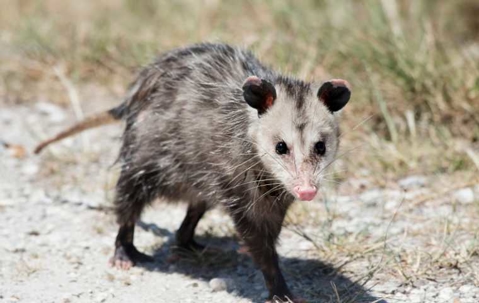Opossums are marsupials native to North and South America, known for their unique appearance. They have several distinctive features:
- Body Size and Shape: Opossums are typically small to medium-sized animals, with a body length ranging from about 10 to 20 inches (25 to 50 cm). Their bodies are somewhat stocky and can weigh between 4 to 14 pounds (2 to 6.5 kilograms), depending on the species and age.
- Fur: Their fur is generally coarse and grayish-white, with a mix of white and black guard hairs. This gives them a grizzled or "salt-and-pepper" appearance. The fur covers their entire body, including their long, scaly tail.
- Head: Opossums have a pointed snout with a pink or flesh-colored nose, which is one of their distinguishing features. Their ears are hairless and prominent, with a pinkish hue. They have sharp, pointed teeth, and their mouth opens wide, displaying numerous teeth.
- Eyes: Opossums have small, black, beady eyes that are adapted for nighttime vision, as they are primarily nocturnal animals.
- Tail: Their prehensile, hairless tail is quite remarkable. It helps them balance when climbing trees and can also be used to grasp objects. The tail can be as long as their body or even longer.
- Limbs and Feet: Opossums have five toes on each foot, with sharp claws that are well-suited for climbing trees and digging. Their hind legs are longer than their front legs, making them agile climbers.
- Marsupial Pouch: Female opossums have a marsupial pouch, similar to kangaroos, where they carry and nurse their young. This pouch is located on the abdomen and opens to the rear.
- Behavior: Opossums are known for their slow and deliberate movements. They are often seen waddling or shambling when walking. When threatened or frightened, they may hiss and show their teeth as a defense mechanism. Additionally, opossums are known for "playing dead" when confronted by predators, a behavior known as "playing possum."
Opossums are unique-looking marsupials with grayish-white fur, a pointed snout, pinkish nose, hairless ears, sharp teeth, beady eyes, and a distinctive prehensile tail. Their appearance and behaviors make them easily recognizable in their natural habitats.
How Big Do Opossums Get?
The size of opossums can vary depending on their species, age, and geographic location. However, I can provide a general overview of the typical size ranges for opossums:
- Body Length: Opossums typically have a body length ranging from approximately 10 to 20 inches (25 to 50 centimeters). This measurement includes their head and body, but it does not include their tail.
- Tail Length: Opossums have long, prehensile tails that can be almost as long as their bodies. The tail can range from about 9 to 20 inches (23 to 51 centimeters) in length.
- Weight: Opossums vary in weight based on factors such as age, sex, and diet. On average, they weigh between 4 to 14 pounds (2 to 6.5 kilograms). However, it's important to note that larger individuals can occasionally be found, and younger opossums tend to be smaller.
- Sexual Dimorphism: Male opossums are generally slightly larger and heavier than females, although the difference in size is not extreme.
- Geographic Variation: The size of opossums can also vary based on their geographic location and the specific species. For example, the Virginia opossum, which is the most well-known opossum species in North America, is typically larger than some of its South American relatives.
Opossums are generally small to medium-sized marsupials, with body lengths ranging from 10 to 20 inches (25 to 50 centimeters), tails that can be almost as long as their bodies, and weights varying from 4 to 14 pounds (2 to 6.5 kilograms). These measurements can vary somewhat based on factors like age and species, but this provides a good overview of their typical size range.
What Color Are Opossums?
Opossums are known for their distinctive coloration, which can be described as follows:
- Fur Color: The fur of opossums is typically grayish-white to light gray. It has a somewhat coarse texture and is often described as "salt-and-pepper" or "grizzled" in appearance. This mottled coloration helps them blend into a variety of environments, from forests to urban areas.
- Guard Hairs: Opossums have a mix of white and black guard hairs in their fur. These guard hairs contribute to their grizzled appearance. The arrangement of these hairs varies among individuals, giving each opossum a somewhat unique pattern.
- Face and Ears: Their faces are covered in the same grayish-white fur, and their ears are hairless and pinkish in color. The pink or flesh-colored nose is another distinctive feature of their facial appearance.
- Tail: Opossums have a long, prehensile tail that is also covered in grayish-white fur. The tail can sometimes appear darker towards the tip.
- Marsupial Pouch: In female opossums, the marsupial pouch is located on the abdomen and is hairless. It is generally a lighter color compared to the fur.
- Variation: While the described coloration is typical for opossums, there can be some variation among individual animals and species. For example, some opossums may have slightly different shades of gray or variations in the intensity of the mottling.
Opossums' coloration is adapted for camouflage in their natural habitats, and it helps them blend into a variety of environments, especially at night when they are most active. Their unique appearance makes them easily recognizable in the wild.

